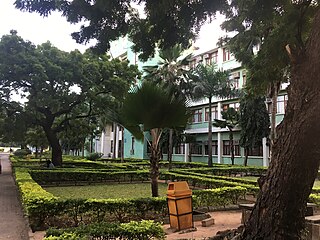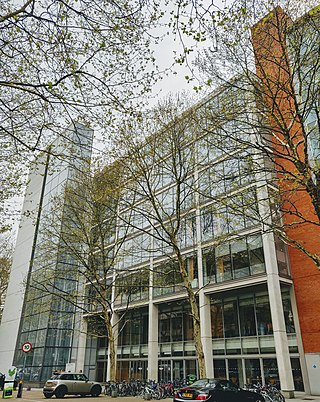Related Research Articles

The University of Botswana (UB) was established in 1982 as the first institution of higher education in Botswana. The university has three campuses: one in the capital city Gaborone, one in Francistown, and another in Maun. The university is divided into six faculties: Business, Education, Engineering, Humanities, Health Sciences, Science and Social Sciences and the Sir Ketumile Masire Teaching Hospital.
Mbarara University of Science & Technology (MUST), commonly known as Mbarara University, is a public university in Uganda. Mbarara University commenced student intake and instruction in 1989. It is one of the ten public universities and degree-awarding institutions in the country. MUST is accredited by the Uganda National Council for Higher Education.

Brighton and Sussex Medical School (BSMS) is a medical school formed as a partnership of the University of Brighton and the University of Sussex. Like other UK medical schools it is based on the principles and standards of 'Tomorrow's Doctors', an initiative by the General Medical Council outlining the role of British practitioners. Since opening in 2003, BSMS has produced more than 1,500 new doctors who now work across the UK.

The Jawaharlal Institute of Postgraduate Medical Education & Research (JIPMER) is a medical school located in Pondicherry, India. JIPMER is an Institute of National Importance (INI) and a tertiary care referral hospital. It is under the direct administrative control of the Ministry of Health and Family Welfare, and Indian Government, with autonomy to run its internal administration.
Egerton University is a public university in Kenya. It is the oldest institution of higher education in Kenya.
Aberdeen University School of Medicine, Medical Sciences & Nutrition contains the Medical School and Dental School at the University of Aberdeen in Scotland. It also provides training and carries out research in medical sciences, nutrition, public health, dentistry, health sciences, physician associate studies at BSc, MSc, and PhD levels. The current school was formed from the merger of the former School of Medicine & Dentistry, School of Medical Sciences, and the Rowett Institute of Nutrition.

Guntur Medical College is a medical college in Guntur, India. It offers graduate and undergraduate courses in medical sciences. The college is affiliated to Dr. YSR University of Health Sciences and is in the process of becoming autonomous as Guntur Institute of Medical Sciences.

Uganda Martyrs University (UMU) is a private University affiliated with the Roman Catholic Church in Uganda. The University is owned by the Episcopal Conference of the Catholic Bishops of Uganda. It is licensed by the Uganda National Council for Higher Education. UMU consists of seven Faculties, two Institute, six Campuses, nine Departments, and three schools. As of March 2022, total student enrollment is 4,632. Of these, about 1,500 students were residential, while nearly 3,000 students were enrolled in UMU's distance learning programs. The number of staff members was over 400.

Muhimbili University of Health and Allied Sciences (MUHAS) ( Chuo Kikuu cha Afya na Sayansi Shirikishi Muhimbili, in Swahili) is a public university located in Upanga West, Ilala District of Dar es Salaam Region in Tanzania. It is accredited by the Tanzania Commission for Universities (TCU).
The Makerere University School of Medicine (MUSM), also known as the Makerere University Medical School, is the school of medicine of Makerere University, Uganda's oldest and largest public university. The medical school has been part of Makerere University since 1924. The school provides medical education at diploma, undergraduate, and postgraduate levels.
Makerere University College of Health Sciences (MakCHS) is a constituent college of Makerere University, Uganda's oldest university. The schools of the college offer undergraduate and postgraduate courses in the biomedical sciences, health sciences, human medicine and public health, covering a broad range of disciplines and specialties.
Makerere University College of Health Sciences (MakCHS), is one of the 10 colleges that constitute Makerere University, East Africa,s oldest university. The college was established in 2007 by consolidating the training offered by the University in the disciplines of Medicine, Dentistry, Pharmacy, Nursing, Public Health, Optometry, Radiography and other health sciences. The college of Health Sciences consists of 5 schools: School of Medicine, School of Public Health, School of Biomedical Sciences, School of Dentistry and School og Health Sciences. The college provides training in the health sciences at the undergraduate, masters, PhD and post- doctoral levels levels.

The Faculty of Medicine is the academic centre for medical and clinical research and teaching at Imperial College London. It contains the Imperial College School of Medicine, which is the college's undergraduate medical school.
Uganda Martyrs University School of Medicine, whose official name is Mother Kevin Postgraduate Medical School, is the school of medicine of Uganda Martyrs University. As of June 2014, the medical school is the newest medical school in Uganda, having been established in 2010. Currently the school provides postgraduate medical education in the disciplines of Pediatrics, Internal Medicine, Surgery, Obstetrics/Gynecology and Emergency Medicine.
Kampala International University School of Health Sciences is the school of health sciences of Kampala International University, a private Ugandan university. The school provides health sciences education at the diploma, undergraduate and postgraduate levels.

The Busitema University Faculty of Health Sciences (BUFHS), also known as the Busitema University Medical School (BUMS) and the Busitema University School of Medicine (BUSM), is the school of medicine of Busitema University, one of Uganda's public universities. The medical school is one of the newer medical schools in the country, having been part of university since 2013. The school provides medical education at undergraduate and postgraduate levels.
Gulu University School of Medicine (GUSM), also known as Gulu University Medical School (GUMS) is the school of medicine of Gulu University, one of Uganda's public universities. The medical school was founded in 2004, two years after Gulu University was established. The school provides medical education at diploma, undergraduate and postgraduate levels.
Micheal Chilufya Sata Copperbelt University School of Medicine (MCSCBUSOM), also known as Copperbelt University Medical School is the school of medicine of Copperbelt University in Zambia. The medical school is the country's second public medical school, the other being the University of Zambia School of Medicine. The school provides medical education at undergraduate and postgraduate levels.

The University of Zambia School of Medicine (UNZASOM), also known as University of Zambia Medical School is the school of medicine of the University of Zambia. The medical school is the country's first public medical school, the other being the Copperbelt University School of Medicine. The school provides medical education at undergraduate and postgraduate levels.
The University of Malawi College of Medicine (UMCM), also Malawi College of Medicine in Blantyre, is a constituent college of the University of Malawi, the oldest and largest public university in the country. The college houses the Faculty of Medicine of the University, and is the only medical school in Malawi.
References
- 1 2 3 4 Segametsi Kebonang (20 May 2014). "School of Medicine produces first graduates". Botswana Daily News. Gaborone. Retrieved 14 May 2018.
- 1 2 Gaonyadiwe G. Mokone; Maikutlo Kebaetse; et al. (August 2014). "Establishing A New Medical School: Botswana's Experience". Acad. Med. 89 (8 0): 83–87. doi:10.1097/ACM.0000000000000329. PMC 4116079 . PMID 25072587.
- 1 2 3 4 5 6 University of Botswana (24 March 2018). "University of Botswana: Faculty of Medicine". Gaborone: University of Botswana . Retrieved 24 March 2018.
- ↑ Google (24 March 2018). "Location of the Campus of the University of Botswana School of Medicine" (Map). Google Maps . Google. Retrieved 24 March 2018.
- ↑ Globefeed.com (24 March 2018). "Distance between University of Botswana, Gaborone, Botswana and University of Botswana Teaching Hospital, Gaborone, Botswana". Globefeed.com. Retrieved 24 March 2018.
- ↑ "Botswana-UPenn Partnership" . Retrieved 4 June 2020.